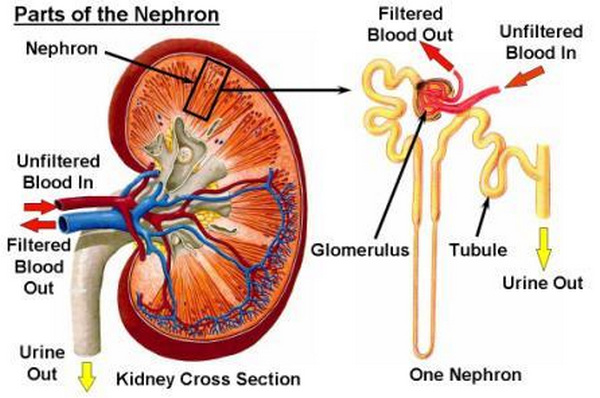Estimated Glomerular Filtration Rate ( eGFR) Test & Calculators
Last reviewed by Editorial Team on February 27th, 2019.
An estimated glomerular filtration rate test measures the function of the kidney and helps in determining the stage of kidney disease.
It pertains to the amount of blood filtered by glomeruli per minute.
To find out the estimated glomerular filtration rate, your doctor will calculate the result of your blood creatinine with considerations to your age, gender, and body size.
A low glomerular filtration rate indicates that the kidneys are not working the way they supposed too. The normal glomerular filtration rate in adults is more than 90.
However, it is important to take into consideration the age of the patient as the number declines with age. (1, 2)

Image 1: The human kidneys indicating the functions of the glomerulus.
Picture Source: unckidneycenter.org

Picture 2: A glomerular filtration rate detects the functions of the kidneys.
Photo Source: kidney.org
Why is it important to undergo an estimated glomerular filtration rate test?
It is important in assessing the functions of the kidneys.
The result of the test will be used by the doctor in diagnosing and staging kidney disease. It is also helpful in monitoring chronic kidney disease and coming up with an appropriate treatment plan.
The glomerular filtration rate is based on the blood test for creatinine. Although the glomerular filtration test is good, it is not always right for everyone.
It could lead to inaccurate results if you are:
- Below 18 years old
- Pregnant
- Very muscular
- Overweight
- Elderly
- People that follow a vegetarian diet (2, 3)

Photo 3: A blood is drawn from the patient’s arm and the creatinine level is checked and the GFR is calculated based on the creatinine level and other factors.
Image Source: images.wisegeek.com
When is the procedure ordered?
It is ordered by the doctor if he/she thinks that you have a kidney damage or at risk for developing kidney-related diseases. Clinical manifestations that warrant a glomerular filtration rate test include the following:
- Foamy urine
- Inability or difficulty urinating
- Unexplained swelling of the body
- Mid-back pain
- If you have a health condition that can significantly affect the functions of the kidneys such as:
- Diabetes
- Heart-related diseases
- Hypertension
- Recurrent urinary tract infection
- Polycystic kidney disease
- Kidney failure (3, 4)
What are glomeruli?
They are structures in the kidneys that serve as tiny filters. They allow the waste products to be removed from the blood and prevent the loss of vital constituents such as the proteins and blood cells.
How is the glomerular filtration rate test performed?
A blood sample is drawn from your arm and will be sent to the lab for a thorough examination.
The creatinine level in the blood sample will be determined and the glomerular filtration rate will be calculated based on the level of creatinine and other factors such as the age, gender, race, height, and weight.
How to calculate for a glomerular filtration rate?
There are several formulas used to calculate the glomerular filtration rate but the most common ones are the:
Cockcroft & Gault – It accounts for the age, gender, and muscle mass and multiplied by 1.23 for men. The formula to be used is
Creatinine clearance = [140 – age (years)] x LBW (kg) x 1.23 (if male) (mls/min)
Serum creatinine (umol/L)
MDRD (Modification of Diet in Renal Disease) formula – To use this formula, you will need to know your creatinine level, age, gender, and race. For sample computation: 186.3 x Serum Creatinine (exp[-1.154]) x Age (exp[-0.203]) x (0.742 if female) x (1.21 if African American).
GFR Calculators
MDRD for Adults (SI Units) Calculator
What is the normal GFR of a kidney?
Healthy kidneys can filter about 200 quarts of blood and can produce 2 quarts of urine. A person suffering from a kidney-related disease has a low glomerular filtration rate.
This indicates that the waste products start to accumulate in the blood.
Through the glomerular filtration rate, a kidney dysfunction can be detected at an early stage and the damage can be minimized with appropriate treatment plan. (2, 4, 5)
GFR Test Preparations
The only thing you should do before undergoing a glomerular filtration rate test is to fast overnight and to not eat cooked meat as research shows that eating cooked meat prior to testing can significantly increase the level of creatinine.
You should inform your doctor if you are taking certain drugs prior to the procedure as some drugs may affect the level of creatinine such as:
- Cisplatin
- Antibiotics like cephalosporin and aminoglycoside
- Flucytosine
- Cimetidine
- Ibuprofen
- Trimethoprim (5)
Interpreting the test result
What is the normal glomerular filtration rate level?
According to the National Kidney Foundation, the adult normal eGFR is greater than 90 mL/min/1.73m2. However, the actual number is only reported when the rate is below 60 mL/min/1.73m2.
A less than 60 mL/min/1.73m2 indicates that there is some kidney damage.
If the person’s glomerular filtration rate remains in this level for more than three months, then it indicates that the person is already suffering from a chronic kidney disease. (6, 7)

Image 4: The image shows the glomerular filtration rate and interpretations.
Picture Source: www.niddk.nih.gov
Estimated glomerular filtration rate and the corresponding stages of kidney damage.
- Stage 1 – glomerular filtration rate of 90 or higher – The kidneys are of normal function.
- Stage 2 – glomerular filtration rate of 60 to 89 – There is a damage to the kidneys as characterized by a minimal loss of kidney functions.
- Stage 3a – glomerular filtration rate of 45 to 59 – There is already a mild to moderate loss of kidney functions.
- Stage 3b – glomerular filtration rate of 30 to 44 – There is a moderate to severe loss of kidney functions.
- Stage 4 – glomerular filtration rate of 15 to 29 – There is a severe loss of kidney function.
- Stage 5 – glomerular filtration rate of less than 15 – It indicates a severe kidney failure. (4, 6, 7, 8)
Aside from knowing the glomerular filtration rate of a person, the doctor might also want to consider ordering other procedures such as:
- Imaging studies such as CT scan and ultrasound of the urinary tract and kidneys
- Kidney biopsy (9)
Are there any possible risks?
The possible risk has something to do with the drawing of blood. Some people have visible veins and arteries while others are difficult to visualize. With this, some possible risks include:
- Trauma to the skin secondary to numerous needle insertion
- Excessive bleeding
- Accumulation of blood under the skin
- Infection
- Light-headedness (4, 10)
References:
- https://www.kidney.org/atoz/content/gfr
- http://www.kidneyfund.org/prevention/tests-for-kidney-health/egfr-test.html
- https://labtestsonline.org/tests/estimated-glomerular-filtration-rate-egfr
- https://www.niddk.nih.gov/health-information/professionals/clinical-tools-patient-education-outreach/explain-kidney-test-results
- https://www.healthline.com/health/glomerular-filtration-rate
- https://medlineplus.gov/ency/article/007305.htm
- https://www.webmd.com/a-to-z-guides/glomerular-filtration-rate
- https://www.myvmc.com/investigations/glomerular-filtration-rate-gfr/
- https://www.davita.com/tools/gfr-calculator
- http://www.childrenshospital.org/conditions-and-treatments/treatments/glomerular-filtration-rate-test
Similar Posts:
- BUN/Creatinine Ratio Understand (High vs. Low Levels, Normal Range)
- Types of Blood Cells
- Methyl Red Test
- Buffy Coat
- Benedict’s Test
